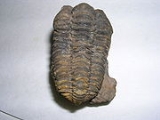
Flexicalymene
Encyclopedia
Flexicalymene is a genus of trilobites of the order Phacopida
, suborder Calymenina
. They are found abundantly in North America. Flexicalymene specimens can be mistaken for Calymene
, Gravicalymene
, Diacalymene
and a few other Calymenina
genera. They are used as an index fossil in the Ordovician
. Ohio and
North America are particularly known for being rich with Flexicalymene fossils. Species include F. meeki and F. retrorsa (Ohio, Kentucky and Indiana), F. granulosa (Ohio, Kentucky and Quebec), F. senaria (Quebec) and F. croneisi (Ontario).
Flexicalymene fossils can be found at an age of 95–110 mya.
Phacopida
Phacopida is an order of trilobite that lived from the Ordovician to the Devonian. It is made up of a morphologically diverse group of related suborders....
, suborder Calymenina
Calymenina
Calymenina is a suborder of the trilobite order Phacopida....
. They are found abundantly in North America. Flexicalymene specimens can be mistaken for Calymene
Calymene
Calymene is a genus of trilobites in the order Phacopida that were found throughout North America, North Africa, and Europe in primarily Silurian outcrops. Calymene are easily confused with Gravicalymene and Flexicalymene, also part of the Calymenidae family...
, Gravicalymene
Gravicalymene
Gravicalymene is a genus of trilobites from the order Phacopida, suborder Calymenia. Gravicalymene has been a 'hot button' trilobite lately. The species that are currently in this genus have been in Calymene and Sthenocalymene...
, Diacalymene
Diacalymene
Diacalymene is a genus of trilobite from the order Phacopida, suborder Calymenina. It includes the species D. ouzregui, D. clavicula, D. diademata and D. gabrielsi. It lived in the Ordovician and Silurian periods....
and a few other Calymenina
Calymenina
Calymenina is a suborder of the trilobite order Phacopida....
genera. They are used as an index fossil in the Ordovician
Ordovician
The Ordovician is a geologic period and system, the second of six of the Paleozoic Era, and covers the time between 488.3±1.7 to 443.7±1.5 million years ago . It follows the Cambrian Period and is followed by the Silurian Period...
. Ohio and
North America are particularly known for being rich with Flexicalymene fossils. Species include F. meeki and F. retrorsa (Ohio, Kentucky and Indiana), F. granulosa (Ohio, Kentucky and Quebec), F. senaria (Quebec) and F. croneisi (Ontario).
Flexicalymene fossils can be found at an age of 95–110 mya.

